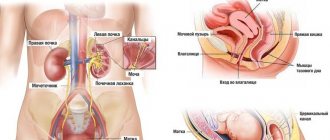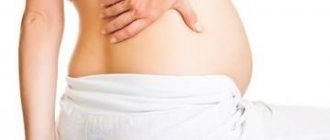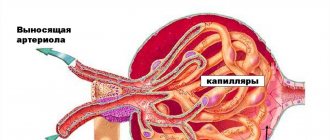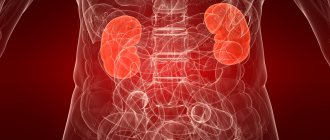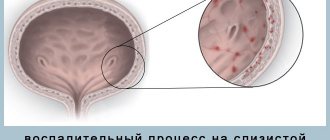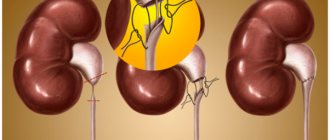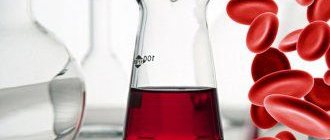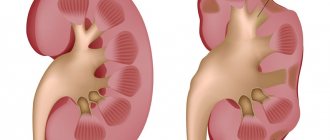The ovaries are the paired female genital organs, which are responsible for the proper production of hormones and the maturation of the egg. Their sizes, reactions and secret activities at different times are not the same.
Quite often, women turn to a gynecologist complaining of pain in the ovarian area. The appearance of pain in the lower abdomen is the main symptom of a disease of the appendages. Most often, pain occurs on the left side, which can radiate to the hip or lower back. In this article we will tell you why the left ovary hurts and in what cases it is necessary to contact a gynecologist.
Causes of pain on the left
If a woman has pain in the ovary on the left, this may indicate not only ovulation or the imminent onset of menstruation, but also the development of diseases of the reproductive organs.
The following are the causes of pain:
- inflammation;
- rupture of the appendage (apoplexy);
- cyst;
- torsion;
- ectopic pregnancy;
- recent pelvic surgery.
Let's look at each cause of pain in more detail.
Inflammatory diseases
If the left ovary is pulled and there is sharp pain in the spine or lower abdomen, this indicates inflammation (oophoritis). The disease first develops in one appendage, and then affects the other. As a result, the patient has pain in the right and left ovaries at the same time. The appearance of oophoritis is facilitated by infection in the pelvic organs. Most often, infection is caused by mycoplasma, ureaplasma and other microorganisms. Inflammation quickly manifests itself in a woman’s body, resulting in pain in the left ovary. This may be tingling in the lower back, pulling or aching pain in the groin area.
Some of the main causes of inflammation are hypothermia, a weakened immune system, and overwork of the body. A woman becomes irritable, has poor sleep, headaches and decreased performance. Soon pain appears in the lower abdomen. Incorrect treatment or its absence leads to the inability to bear a child or become pregnant.
If you experience acute pain in the left ovary or intense tingling in the lower back, you should immediately consult a doctor!
Ovarian rupture
Apoplexy is a violation of the integrity of the ovary, which is accompanied by increased heart rate, fever, vomiting, weakness and excessive sweating. If the rupture occurred on the left, then, accordingly, the left appendage tingles. The pain is acute, it is impossible to endure it. Sometimes a woman may lose consciousness.
Cyst
A cyst is a neoplasm on the ovary, the symptoms of which can easily be confused with other diseases of the pelvic organs. It can occur on both the left and right ovary. If several cysts appear on both appendages, the patient is diagnosed with polycystic disease.
Cystic formation threatens apoplexy, torsion of the leg, and infertility. Increasing in size, the cyst begins to put pressure on nearby pelvic organs. Such pressure leads to poor blood circulation, disruption of the normal functioning of other organs, inflammation and death of appendage tissue. During this period, the girl experiences a dull pain, which is localized on the side where the tumor appeared. For example, a cyst on the left ovary will manifest as discomfort in the left side of the abdomen.
Torsion
Ovarian torsion is a revolution of the ligaments of the appendage, in which there is compression of the vessels and disruption of the nutrition of the ovary. Accompanied by nausea, vomiting, spasmodic and stabbing sensations in the lower abdomen on one side (in this case, the left). Sometimes the left ovary tingles.
Most often, ovarian torsion occurs during sports, heavy work, or other physical activity. As a result, mobility of the appendages occurs, which soon begin to ache. This disease often occurs in active girls during childhood.
Types of incorrect embryo attachment
Where does it hurt?
In a situation where pain occurs, it is usually difficult to indicate a specific location, because they have an aching and pulling nature, radiating in different directions and nearby organs. But the source of pain is localized on the side where the ovarian cyst is located and growing.
While the cyst increases in volume and does not manifest any symptoms, there is therefore no treatment for this disease and complications, even life-threatening, may occur.
The pain will appear on the right side, radiating to the right leg and thigh. Severe pain in the right lower abdomen at the beginning and after the menstrual cycle, after sex, physical activity.
Appears similarly in the left part of the lower abdomen, of a pulling nature. Acute pain is usually in the left side of the lower abdomen during the menstrual cycle, after sex, or physical activity.
Also, these sensations are complemented by other symptoms, which together can be used to determine an accurate diagnosis. There may be an increase in the size of the abdomen, a feeling of distension and fullness.
Ectopic pregnancy
If the fertilized egg attaches incorrectly, for example, to the left ovary, an ectopic pregnancy develops. In this case, the woman experiences a pulling or cramping pain on the left side of the abdomen, which radiates to the lower back or rectum.
An ectopic pregnancy should be terminated as early as possible in order not only to prevent the development of complications, but also to preserve reproductive function.
If the left ovary hurts and at the same time there are other signs of a pathological pregnancy (bloody discharge, weakness, etc.), you need to contact a gynecologist and have an ultrasound of the pelvic organs.
Where does the pain occur?
An ovarian cyst hurts on the right or left side of the lower abdomen. The localization of discomfort depends on the location
affected organ. Most often the nature of the pain is aching, less often – acute. It depends on the type of formation and its size. Pain can radiate to other parts of the abdominal cavity, to the lower back, sacrum, groin, rectum and lower extremities. Sometimes, with an ovarian cyst, the lower back hurts constantly, which can occur simultaneously with discomfort in the lower abdomen.
Pain after surgery
Absolutely any surgical intervention is considered a major injury and shock to the body. That is why pain after surgical procedures is acceptable and does not pose a threat to the body. But if the ovaries do not stop pulsating, aching, or dragging for several weeks, and the pain intensifies, the woman needs to consult a specialist.
One of the common operations of the appendages is follicular puncture, the postoperative period of which is also accompanied by painful sensations. A woman may also experience discharge with an unpleasant (sour) odor, severe bloating and aching pain in the left ovary. Such signs are associated with injury to the tissues and vessels of the appendage, although the injection itself is practically painless.
During the puncture, a small bleeding wound or hematoma is formed, which aches for some time. The pain lasts no more than five days. If the pain does not subside, is accompanied by fever, unusual discharge appears, bloating or loss of consciousness, you should consult a doctor.
Recommendation
If pain occurs, you must definitely reduce physical activity, be less active in general and in sexual relationships, in order to avoid the development of complications such as rupture and twisting of the leg of the inflamed ovarian cyst.
Many women, during a routine examination with a gynecologist, during an ultrasound, find out that they have an ovarian cyst. Depending on the nature of its appearance, its size, individual treatment is selected, or the doctor continues to monitor it to know whether it can resolve on its own or not.
Pain arising from an ovarian cyst is an alarming symptom for a woman. It may indicate an increased pace of development of education, its gap. In each case, the nature of the pain is different. A woman should consult a doctor to avoid serious consequences in the future.
Pain during intercourse
Active sex using a variety of positions is sometimes accompanied by discomfort in the lower abdomen. In this case, pulsation, aching, and pricking may occur in both the left and right ovaries. Unfortunately, this manifestation does not bode well.
The main causes of pain during sex in the left ovary can be:
- inflammation and infections of the genital organs;
- cyst;
- penetration too deep;
- muscle tension;
- cervicitis;
- vaginal dryness;
- adhesive processes.
In any case, if painful sensations are observed with every sexual intercourse, you should consult a gynecologist.
Painful sensations in the left ovary in early pregnancy may indicate the presence of a corpus luteum cyst.
Formations in the gland
The next common causes of complications in the appendage are cystic formation and polycystic disease.
With a cyst, the patient often experiences discomfort during sex and pulls in the lower abdomen. The symptoms are attributed to approaching menstruation or a cold.
The cavity with liquid gradually grows and does not cause discomfort. The cyst is detected by ultrasound examination.
The danger lies in the fact that the cyst may burst (rupture) or the leg may be torsioned.
A sudden deterioration in health entails nausea with vomiting, and rarely loss of consciousness.
A characteristic aching pain also occurs when hormones malfunction. During an ultrasound examination, the doctor discovers polycystic disease.
Multiformation of cysts is accompanied by changes in health status:
- periods are heavy or scanty;
- mood swings and other PMS symptoms are ubiquitous;
- causeless weight gain, hair loss, skin irritation.
Surgery after diagnosis is a last resort measure to solve the problem. In the early stages, detected polycystic ovary syndrome responds positively to drug treatment.
Conclusion
Painful sensations before, during or after menstruation, radiating to the right side, warn of pathology. You cannot ignore such messages from the body.
A timely visit to a gynecologist will dispel your doubts or help identify the problem. Prevention is the best cure!
Pain during pregnancy
Among many women, there is an opinion that pain in the ovaries is the main sign that a girl is pregnant. But statistics show that this pain syndrome is absolutely not associated with the appendages. This is due to the fact that during the period of bearing a baby, the uterus stretches, the ovaries rise above the place where they were previously located.
Pain during pregnancy is caused by stretching of the ligaments that support the appendages and uterus. Ovarian tension occurs in women. The expectant mother can cope with such discomfort on her own through proper nutrition, frequent rest and light exercise.
If the pain bothered you even before pregnancy and continues further, then you should visit a doctor. It is necessary to find out the causes of pain in the left ovary as early as possible, since it can not only be enlarged, but also pose a threat to the child.
You should also remember the preparation for conception and preventive methods of diseases even before pregnancy, since the appendages can get sick already during pregnancy and have completely different consequences, including miscarriage and placental abruption.
Causes of pain not associated with serious illnesses
The main reason why the ovary may hurt is considered to be hormonal changes in the female body that occur during menstruation and ovulation. Ovulation is accompanied by the rupture of the dominant follicle and the release of the egg. As a result, irritant effects occur on the nerve endings, which can lead to variable pain on both sides at once. However, if a mature egg has come out of a follicle located on the left ovary, then, accordingly, there will be discomfort on the left. There have been cases when women felt ovulatory pain even at 8 DPO (day after ovulation)
Many people are interested in why pain occurs in the appendage area during menstrual periods. This is due to a decrease in estrogen levels or endometriosis. It is endometriosis that manifests itself most during menstruation. A woman experiences not only pain in the appendages, but also constant nausea, weakness, loss of strength, and difficulty urinating and defecating.
Unpleasant sensations due to endocrine pathologies
In some cases, the ovary is pulled due to hormonal disorders. Since the gonads are endocrine organs, their functioning depends on the work of the pituitary gland. Hormonal imbalances can lead to a decrease in estrogen production in the ovaries. This, in turn, is fraught with infertility and the development of other pathological conditions.
Excessive release of female sex hormones is also harmful to the body. Hyperestrogenism is one of the main predisposing factors in the development of oncological processes of the cervix, endometrium and ovaries. In addition, hormonal imbalance can lead to breast cancer.
Primary diagnosis and pain relief
As mentioned earlier, if a girl feels discomfort in the left ovary, then there are various reasons for this. Some do not pose a threat to health and disappear on their own in the near future. Others appear periodically and with varying intensity. It is these symptoms that should alert you, as they can lead not only to a deterioration in your general health, but also to infertility. What to do in this situation? The first thing you need to do is contact a specialist and undergo a gynecological examination. Using palpation, the gynecologist will palpate the ovaries, determine their size and localization of pain. This pressure on different areas of the lower abdomen makes it possible to find out the main cause of discomfort in the left ovary and will direct you to an ultrasound to confirm or refute the diagnosis. To determine the cause for sure, a specialist may also prescribe tests.
You can relieve painful symptoms yourself. However, this should only be done after consulting a doctor. To do this, you must adhere to the following recommendations:
- pause training and avoid other intense physical activities;
- eat well and add as many vitamins as possible to your diet;
- do not drink or smoke;
- avoid conflict situations and stress;
- take painkillers.
Thus, the appearance of even minor pain in the left ovary requires a mandatory examination and compliance with all the instructions of a specialist.
Pain when breaking
The sensations accompanying the rupture of education should be considered separately. A follicular cyst, the rupture of which occurred in the middle of ovulation, may not bother you. After a dermoid formation ruptures, a woman may fall into a state of shock, the pain is so severe.
Regardless of the type of cyst, the pain after the rupture occurs in the lower abdomen. Gradually spreads higher, lower back pain may occur. The factor leading to such consequences is often sexual intercourse performed in a harsh form, intense physical activity, or trauma to the pelvic organs. Making attempts to change position and move, the woman feels an increasing attack of pain.
Until the moment of rupture, pain appears, covering the pelvic part, sacrum, and lower back. Many people do not pay attention, stopping the attack. The duration of pain after rupture causes tachycardia, a sharp decrease in blood pressure, loss of consciousness, and shock.
How can you understand that it is the kidneys that hurt in the lower back?
Have you been trying to cure your KIDNEYS for many years?
Head of the Institute of Nephrology: “You will be amazed at how easy it is to heal your kidneys just by taking it every day.
Our readers successfully use Renon Duo to treat kidneys. Seeing how popular this product is, we decided to bring it to your attention. Read more here...
Everyone knows how important kidneys are for the body. However, how can you understand that your kidneys are hurting and not something else, because often unpleasant sensations can be confused with ordinary back pain? As you know, without this organ a person cannot survive, since the kidneys are responsible for processing and removing toxins and wastes that enter the body. Despite its importance, people rarely take care of the health of their kidneys, but if they function incorrectly, serious disruptions in the functioning of the entire body are possible.
The pain can be quite severe, and a person does not always know how to distinguish kidney pain from ordinary back discomfort. Everyone needs to know how exactly the kidneys hurt. Thanks to this, a person has the opportunity to prevent the development of serious pathology and avoid dangerous complications. Often, kidney problems affect the condition and functioning of the genital organs, as well as the reproductive system.
There can be many reasons for problems with the kidneys, but most often problems with this organ occur in people with persistent disorders of the digestive system, impaired water-salt and protein balance. As a result, the kidneys stop working normally, which manifests itself not only in the form of pain, but also in problems with muscles and joints.
Diagnostic methods
It is very difficult to determine the disease of a particular organ without consulting a specialist and a thorough examination. For example, only a doctor knows how to determine whether the lower back or kidneys are hurting. Although there are a number of symptoms that indicate that health problems lie in the kidneys. To do this, you need to know exactly where this pair of organs is located and exactly how the pain associated with them manifests itself.
Many people know that when the kidneys hurt, the discomfort affects the lumbar region. However, a disease such as osteochondrosis can also manifest itself in this area. So how do you know if your kidneys are hurting or if this is a sign of another disease? The easiest way is to lightly tap on the lower rib. This action should result in quite severe pain (this is physical or emotional suffering, a painful or unpleasant sensation) in the lower back.
It is worth noting that in cases where we are talking about problems with the kidneys, painful sensations (sensory experience is a mental process that is a mental reflection of individual properties and states of the external environment, the subject of internal or external stimuli and irritants) are of a constant nature, then there is an unpleasant symptom that does not leave the patient when the body position changes or when the nature of movements changes. Most often the kidneys hurt at night. For comparison, painful sensations in the musculoskeletal system are always associated with human movement and appear periodically.
If we are talking specifically about kidney disease, then, in addition to constant discomfort in the lumbar region, symptoms such as dry mouth, constant thirst, nausea and vomiting, lack of appetite, sudden weight loss, vision problems, and swelling of the limbs may be noted. . In some cases, there may be blood in the urine and an increase in body temperature. In addition, kidney problems lead to difficulty urinating, changes in taste and unpleasant ammonia odor from the mouth.
Characteristics of pain
In kidney disease, the classic symptom is pain that is localized under the ribs on the right or left side, depending on which organ is not functioning properly. As a rule, the nature of the pain (physical or emotional suffering, painful or unpleasant sensation) is constant and aching, often radiating to the lower abdomen and groin area. In rare cases, patients may feel unpleasant sensations (sensory experience is a mental process that is a mental reflection of individual properties and states of the external environment, subject to internal or external stimuli and irritants) on the outer side of the thigh.
Options cannot be excluded when constant nagging pain in the kidneys additionally manifests itself in the form of a sharp acute attack. This is clear evidence that the urinary tract was partially or completely blocked. Sharp pain can be caused by the movement of sharp kidney stones.
Unlike urolithiasis, where the main symptom is acute pain, with pyelonephritis it is difficult for the patient to go to the toilet. In addition, in the presence of such a disease, a rash occurs on the skin, as toxins enter the blood from the kidneys. Kidney diseases can be preliminarily diagnosed by lightly tapping the ribs. If such actions give off a dull pain, we are talking about the kidneys. In other cases, it may be a disease of the joints, spine or musculoskeletal system.
Urolithiasis and inflammation
The problem of kidney stones (Kidney (anatomy) is an organ of the excretory (urinary) system of animals and humans) is very serious, since this disease may not manifest itself for a long time. For this reason, the patient often seeks help from a specialist only at the stage when surgical intervention is indispensable.
With urolithiasis, there is acute pain in the form of sharp contractions. Unpleasant sensations can last quite a long time, and occur not only in the lumbar region, but also in the groin.
If you do not contact a specialist in time, the disease will progress to a more dangerous stage. To this are added unpleasant sensations (sensory experience - a mental process, which is a mental reflection of individual properties and states of the external environment, subject to internal or external stimuli and irritants) when urinating, sediment and blood in the urine. These are very alarming symptoms (one of the individual signs, a frequent manifestation of any disease, pathological condition or disruption of any vital process), which require immediate attention to a specialist.
Kidney stones manifest themselves if a person works hard physically. In this case, unpleasant pain symptoms may occur when bending the body. Too frequent urge to go to the toilet, nausea and vomiting are possible.
If the kidneys are infected or an inflammatory process develops, this will manifest itself in a kind of pain. Such troubles arise due to the penetration of pathogenic microorganisms into the body, which penetrate through the blood through the urethra into the kidneys. As a rule, inflammation affects only one kidney, that is, pain (this is physical or emotional suffering, painful or unpleasant sensation) will be felt only on one side of the lower back. Basically, this symptom is of a pulling nature and is accompanied by discomfort.
If an inflammatory process or an infectious kidney disease occurs in the body during the process of urination, this will be reflected in the form of severe pain and burning. According to statistics, most often inflammatory processes affect the right kidney. This is due to the peculiarity of the circulatory system of the human body.
If this organ is infected, both kidneys will suffer. As a rule, such ailments are accompanied by discomfort in the lumbar region, constant aching pain and severe swelling of the limbs. At the same time, metabolism, water-salt and protein balance are disrupted.
Other diseases
Very often, people confuse the pain that occurs due to kidney disease with manifestations of other ailments. There is an explanation for this, because a large number of diseases manifest themselves with symptoms similar to renal colic. Among the diseases whose symptoms are pain in the lumbar region, it is worth highlighting:
- Appendicitis, in which there is acute pain in the area of the right side, accompanied by nausea, vomiting, increased body temperature and other symptoms similar to kidney disease.
- Pain in the back, or more precisely, in the lumbar region, also occurs in the presence of inflammatory processes in the genitourinary system. In this case, difficulty urinating and swelling, which manifests itself on the legs and face, cannot be ruled out.
- Many ailments associated with the abdominal organs can cause discomfort in the lumbar region.
- Manifestations of osteochondrosis, diseases of the spine and musculoskeletal system are often misleading and are perceived as kidney problems.
- Often, nagging pain in the lumbar region occurs in professional drivers who spend a lot of time behind the wheel. This sign is not a manifestation of renal failure. Sharp pain while walking, which has been familiar to many since childhood, has nothing to do with kidney disease.
Based on this, it is worth noting that if a symptom such as pain in the lumbar region appears, you should immediately seek help from a specialist. All this can be a sign of a serious illness, which, if treated incorrectly or untimely, often develops into a chronic form of the disease or into numerous complications. In this case, curing the disease will be much more difficult.
If a person experiences lower back pain, it is worth paying attention to other symptoms. It is quite possible that we are not talking about the kidneys, but about a completely different organ. In any case, it is necessary to seek help from a medical institution for examination and correct diagnosis.
Features of kidney pathologies
The kidneys are the organ that is responsible for cleansing the body of toxins and waste. Therefore, if problems are observed with them, this affects the functioning of the entire body and the general well-being of a person. The patient may feel constantly tired and unwell. And yet, the main symptom (one of the individual signs, the frequent manifestation of any disease, pathological condition or disruption of any vital process), which indicates disease (this is the state of the body, expressed in the disruption of its normal functioning, life expectancy, and its ability maintain its homeostasis) (this is the state of the body, expressed in the disruption of its normal functioning, life expectancy, and its ability to maintain its homeostasis) of the kidneys (Kidney (anatomy) is an organ of the excretory (urinary) system of animals and humans), is pain in the lumbar region. Often this is considered a sign of a cold and the warming up procedure begins. This is a very big mistake, since warming procedures for kidney failure are very harmful. For this reason, you should not self-medicate and count on a lucky break. You need to seek help from a specialist in time to get the correct diagnosis and treatment.
Impaired kidney function is often caused by a slight aching pain in the bladder. Over time, this symptom can develop into severe pain with cutting during urination. By the way, the process of urine leaving the body in case of renal failure becomes extremely difficult.
Impaired urination often accompanies kidney disease. In this case, the person constantly feels the urge to go to the toilet, and in some cases, urinary incontinence is possible. Considering that during kidney disease (Kidney (anatomy) is an organ of the excretory (urinary) system of animals and humans) they cannot perform their functions normally, the fluid leaving the body becomes cloudy, and sometimes with impurities of sand and blood.
A feature of kidney disease is severe swelling. This manifests itself not only in the limbs, but also on the face, and especially under the eyes. In addition, with kidney problems, there is constant thirst, increased blood pressure and body temperature, vomiting and itching of the skin. Due to insufficient quality of cleansing the body of waste and toxins, blurred vision and poor appetite may occur.
Treatment methods
To get rid of such an unpleasant symptom (one of the individual signs, a frequent manifestation of a disease (this is a state of the body expressed in the disruption of its normal functioning, life expectancy, and its ability to maintain its homeostasis), pathological condition or disruption of any vital process ), like pain in the kidney, it is necessary first of all to eradicate its root cause, for which you should consult a doctor, undergo an examination and follow all the doctor’s instructions during treatment.
A common problem with complications is untreated disease. This happens because as soon as the patient gets a little better, he stops taking the prescribed medications and following the regimen recommended by the specialist. It is very important to complete the entire course of treatment. Plus, it can be supplemented with folk remedies, but only with the permission of the treating doctor.
An effective remedy for cleansing the kidneys is lemon pulp, which is prepared from 2 whole lemons. Citrus fruits should be well washed, but not peeled. They are passed through a meat grinder, and then chopped parsley and 2 tbsp are added. honey It is best to store lemon pulp in the refrigerator.
People who are prone to kidney disease should lead a healthy lifestyle, undergo a timely medical examination and take preventive measures. All this will help minimize the risk of complications and allow you to lead a normal life.
Can the kidneys cause pain in the legs (the paired organ of support and movement of a person)?
Have you been trying to cure your KIDNEYS for many years?
Head of the Institute of Nephrology: “You will be amazed at how easy it is to heal your kidneys just by taking it every day.
Our readers successfully use Renon Duo to treat kidneys. Seeing how popular this product is, we decided to bring it to your attention. Read more here...
Many patients, experiencing local pain in the lower back, also feel pain in the leg. Are the two problems related or not, and can kidney disease cause leg pain? Experts say that this is quite possible. Reason: the kidneys in the body act as a filtering organ, removing metabolic products and toxins. The slightest destruction of functionality will lead to intoxication of the body and cause pain in the legs (paired organ (An organ is a separate set of different types of cells and tissues that perform a specific function within a living organism) of support and human movement), restless legs syndrome.
This happens primarily because when there is an excessive accumulation of toxins, the level of phosphorus increases, the content of magnesium, calcium and other beneficial substances that affect the health of the limbs decrease. However, not all painful sensations in the legs are caused by kidney diseases (Kidney (Kidney (anatomy) - organ of the excretory (urinary) system of animals and humans) (anatomy) - organ of the excretory (urinary) system of animals and humans), but to determine the presence of pathology you will have to undergo an examination and identify an accurate diagnosis of the disease.
Pain radiating to the leg: kidneys (Kidney (anatomy) is an organ of the excretory (urinary) system of animals and humans) or not?
If pain in the kidneys radiates to the leg and/or groin area, this may be the result of pathologies in the pyelocaliceal system of the paired organ
If pain (physical or emotional suffering, a painful or unpleasant sensation) in the kidneys (Kidney (anatomy) is an organ of the excretory (urinary) system of animals and humans) radiates to the leg and/or groin area, this may be the result of pathologies in the collecting pelvis paired organ system. Excessive stretching of the parenchyma does not cause any sensations, since the parenchyma does not have nerve pain receptors, but stretching of the capsule due to the accumulation of fluid and increased pressure causes negative symptoms.
In addition, pain in the leg can also appear as a result of urolithiasis: the passage of a stone causes a focal inflammatory process in the perinephric tissue and affects the tubules, which gives the patient unbearable pain.
Important! If, in addition to pain in the kidneys or leg, there are signs of hematuria and frequent urination, this indicates inflammatory processes and the possible presence of stones. As a rule, the sensations become episodic and are relieved with antispasmodics.
Why does pain occur that radiates to the leg (the paired organ of support and movement of a person)?
Constant aching pain syndrome is an indicator of nephroptosis (prolapse) of the kidney of varying degrees
You should understand in as much detail as possible the reasons why kidney pain (this is physical or emotional suffering, a painful or unpleasant sensation) can radiate to the legs:
- Dull pain on the left or right side of the lower back, radiating to the leg, can be caused by a chronic pathology of an infectious nature, tumor growth and the presence of a neoplasm.
- Constant aching pain syndrome is an indicator of nephroptosis (prolapse) of the kidney (Kidney (anatomy) is an organ of the excretory (urinary) system of animals and humans) of varying degrees. Sometimes fever and frequent painful urination are added, which indicates pyelonephritis. The legs hurt mainly at night, restless legs syndrome occurs, accompanied by convulsions.
- If the pain is aching, spreads not only in the lumbar region, but also in the groin, leg, and radiates to the stomach - this may indicate hydronephrosis. Disturbance in the flow of urine through the ureters causes stimulation of the capsule receptors and an increase in pressure. This stretch “hits” on all sides at once: on the thigh, lower back, groin and stomach.
- Shooting pain in the back and abdomen may indicate kidney cystosis, capsule rupture, or kidney injury. The nature of the pain is aching, pulling and lingering.
- Renal colic is one of the causes of pain radiating to the leg (a paired organ of support and human movement). The reason is stagnation of urine in the renal pelvis due to blockage of the tubules with stones. The pressure inside the organ increases, blood supply decreases, and the patient experiences sharp pain of a paroxysmal nature. Attacks can be short-term (a few seconds) or long-lasting (up to 2-3 days). After the attack ends, the pain in the lower back goes away, but the feeling of recoil in the leg remains.
- Acute, severe, sharp unilateral or bilateral lower back pain sometimes occurs with renal artery embolism or renal ischemia. The intensity of the pain is so severe that the patient sometimes loses consciousness, and an additional sign is visually visible hematuria (blood in the form of drops or clots in the urine).
If the patient has one of the alarming symptoms listed above, you should not delay going to the doctor.
If the patient has one of the alarming symptoms listed above, you should not delay going to the doctor. But there can be many more signs, sometimes the following symptoms are added:
- feverish state, jumps in temperature, pressure;
- blood when urinating;
- very frequent urge to urinate, sometimes false, sometimes impossible due to severe pain (this is physical or emotional suffering, a painful or unpleasant sensation);
- weight loss with a normal diet;
- manifestation of signs of intoxication (nausea, vomiting, dizziness) or peritoneal symptoms;
- long-term renal colic, not relieved by antispasmodics, accompanied by vomiting (strong and literally “from everything,” even from a glass of water);
- a decrease in the total daily volume of urine or a complete absence of urination;
- swelling of the lower back in the kidney area - the formation can be felt with your fingers.
Important! When a patient suffers from kidney disease, aggravated by any of these symptoms, you should immediately call an ambulance or help the patient get to the hospital. Delay in contacting specialists can lead to irreversible consequences, for example, necrosis of renal tissue
Prevention
As they say: “if you have never had kidney pain, you know nothing about pain.” This statement can be disputed, however, in terms of duration and intensity, few sensations can compare with pain (this is physical or emotional suffering, a painful or unpleasant sensation) in the kidneys. Only a doctor will select the necessary treatment after conducting a full course of examination, which includes:
- initial examination, history taking;
- laboratory testing of blood and urine;
- instrumental studies of various types.
Similar article - Cauterization of cervical erosion with nitrogen reviews
Based on the data, a diagnosis will be made, therapy will be prescribed and recommendations will be given. But the prevention of kidney pathologies is a matter that any patient can cope with, even if they have the disease. Diet therapy helps very well by excluding fatty meats, fish and reducing the content of animal fats, salt, sugar, and spices in the diet. Refusal of alcohol, sweet carbonated drinks. Moderate consumption of baked goods, normalization of weight and mandatory drinking regimen. Let us remind you that in the absence of cardiovascular pathologies, kidney glands need to consume at least 2 liters of fluid per day. This volume includes all liquids: soups, juices, including fruit juice. Drinking herbal infusions and traditional medicine recipes (recommended by a doctor) help a lot. And, of course, physical self-care: hygiene, choosing the right wardrobe, feasible exercise and a healthy lifestyle.
Adnexitis - what is it?
Inflammation of the appendages is a pathology caused by infection. This phenomenon in medicine is usually called adnexitis and salpingoophoritis. Inflammation of the appendages in women is a fairly common phenomenon in which the infection affects the appendages of the ovaries. Often, inflammation of the appendages in women occurs due to hypothermia. Many women tend to neglect their health, preferring fashionable, lightweight clothes over warm ones in cold weather. In addition to clothing, rain-soaked shoes and freezing feet can also cause inflammation of the appendages. In addition to hypothermia, inflammation of the appendages can occur due to sexually transmitted infections (chlamydia and gonococcus). During unprotected sexual intercourse, chlamydia and gonococci enter the woman’s vagina, but soon move to other abdominal organs. This is due to the fact that the vagina has an acidic environment to which this type of bacteria is not adapted. As a result, bacteria penetrate the appendages, liver, kidneys and urinary tract, and can cause cystitis, pyelonephritis and other diseases of the genitourinary system. If you notice the symptoms of inflammation of the appendages, which are listed below, then immediate treatment is necessary, otherwise it risks complications and new diseases.
Why does pain occur?
An ovarian cyst is prone to formation when certain body functions are disrupted. This condition is often accompanied by the following symptoms:
- irregular menstrual cycle;
- uterine bleeding during the intermenstrual period;
- peritoneal tension;
- disruption of hormone levels;
- pain in the pelvic area;
- feeling of fullness – occurs when the cyst is large;
- bowel dysfunction, increased gas formation;
- frequent urination;
- increased discomfort after physical activity and sexual intercourse.
If your breasts hurt with a diagnosed ovarian cyst, then the cause of the pathology is a hormonal imbalance.
External factors or features of the education itself contribute to the intensification or occurrence of discomfort. Reasons why an ovarian cyst hurts:
- active sexual intercourse;
- exercise stress;
- rapid growth in education;
- pelvic injuries;
- large size of the cyst and its pressure on neighboring organs;
- rupture of the formation or torsion of its legs.
In some cases, such symptoms may be completely absent; pathology is detected only during a routine medical examination.
Risk factors for pathology
1. Age category. Often inflammation occurs in women under 25 years of age, since before this age the body is still in the formative stage. 2. Douching. When frequent vaginal douching occurs, the protective microflora that prevents the penetration of infections is destroyed. 3. Intrauterine device. This method of contraception puts a woman's health at great risk. The spiral is located in the uterus, and its threads reach the entrance to the vagina. As a result, along these same threads, the infection penetrates into the uterus. 4. Chaotic lifestyle. A large number of partners negatively affects women's health, and the risk of inflammation increases. 5. Sexual intercourse during menstruation. During the menstrual period, due to the dilation of the cervix, the infection easily penetrates into the uterine cavity and causes inflammation.
Routes of transmission
1. Ascending. In this case, harmful bacteria penetrate the uterus and tubes, and they can also enter the bladder and kidneys. The infection can enter a woman’s body through the vagina (after unprotected intercourse), through the rectum (due to its close location to the vagina), and from the urinary tract. 2. Descending or secondary path. Infection occurs due to existing inflammatory processes and diseases of the bladder, kidneys, and appendicitis. Thus, an existing disease in the body spreads and causes inflammation of the appendages. 3. Hematogenous. This route of transmission exists, but contracting the infection this way is extremely rare. As a rule, blood is a sterile liquid, and if bacteria enter the appendages through blood vessels, this indicates sepsis (blood poisoning) in the body.
Diagnosis of the cause of pain
To accurately determine the disease, the patient must be examined by a nephrologist .
But first of all, several types of analyzes are prescribed, on the basis of which preliminary conclusions can be drawn:
- urinalysis (necessary to identify inflammatory processes characterized by the presence of red blood cells and protein in the urine in increased quantities);
- general blood test (helps identify common causes of inflammatory processes);
- biochemical blood test (performed if infectious kidney damage is suspected and allows you to evaluate the composition of urea, which is an indirect sign of the presence of certain microorganisms).
The main diagnostic methods are instrumental examination methods, including ultrasound, MRI and CT. If it is necessary to study the tissues of the affected organ in detail, a biopsy method can be used - separating a small fragment of the kidney for a detailed examination.
Symptoms
Signs of inflammation of the appendages manifest differently in different women. What symptoms a woman will experience depends on the type of bacteria, the cause of the inflammation, the form of the disease (acute/chronic), and the state of the immune system.
The acute form of inflammation of the appendages causes the following symptoms: severe sharp pain in the lower abdomen, high body temperature, weakness, chills, difficulty urinating, abnormal bowel movements and a large accumulation of intestinal gases. Symptoms that accompany the inflammatory process may accompany symptoms of intoxication of the body. If a woman has inflammation of the appendages, then any pressure on them during examination will result in a painful reaction. Sometimes symptoms of inflammation of the appendages can be mistaken for symptoms of appendicitis, intestinal diseases, and kidney diseases. With kidney disease, symptoms of colic also occur, which radiate pain throughout the entire abdominal cavity.
Disease tolerance on the legs
Sometimes when you are bothered by a dull pain in the right or left kidney, this may be the consequences of an early illness without treatment. Such pain may mean that you have formed kidney stones. Kidney stones are a rather unsafe formation that occurs for many reasons.
© shutterstock
Treatment
Inflammation of the appendages can be cured completely without further complications if treatment is completed in a timely manner. If treatment is ignored or started too late, it can transform the pathology into subacute and chronic forms. Chronic inflammation will ensure the occurrence of pathology in an acute form, which will occur in periods. In the chronic form, treatment will not ensure complete recovery, but will only heal the exacerbation, after which remission will occur. The duration of remission will depend on the person’s immunity, possible concomitant diseases and other factors.
In case of acute inflammation, the patient is treated in a hospital under the regular supervision of doctors. As a rule, in acute forms of inflammation, hospital treatment is carried out for approximately 14 days. If the inflammation goes away relatively easily, then treatment is carried out at home. Acute inflammation is treated with antibiotics. However, before prescribing drugs, the doctor takes into account the causes of the disease, the person’s condition, and the factors that contributed to the disease. In addition to antibiotics, treatment includes intravenous medications, injections and tablets. For unbearable intense pain, the attending physician prescribes local painkillers. In order for a course of antibiotic treatment to have effective results, it is necessary to adhere to the exact instructions and treatment regimen prescribed by the attending physician. If you deviate from the treatment regimen, the inflammatory process will begin with renewed vigor.
How to relieve pain from ovarian cysts
Constant pain is a reason to consult a gynecologist to diagnose the disease or adjust its treatment. To quickly alleviate the condition, you can use several methods:
- taking painkillers;
- bed rest – in the absence of abdominal tension and complete rest, the pain becomes less noticeable;
- applying a heating pad to the sore area;
- taking a warm bath.
To relieve pain from premenstrual syndrome and bleeding itself, with the permission of a doctor, it is allowed to take a course of vitamins E, magnesium, and folic acid.
An ovarian cyst is a pathology that requires immediate treatment. In its absence, the woman’s condition may deteriorate due to the constant growth of education. Timely medical intervention will eliminate the pain and the very cause of the disease.
Prevention
1. Regular visits to the gynecologist significantly reduces the risk of advanced inflammation of the appendages in a woman. It is recommended to check your women's health at least twice a year. If inflammation does occur, then it must be completely cured so that the disease does not become chronic. The chronic form of the disease, in addition to constant discomfort and pain, also brings infertility. 2. When engaging in sexual activity, care should be taken to protect yourself if pregnancy is not desired. It is better to warn yourself in advance, because abortions can have the most unfavorable consequences, including causing inflammation of the appendages. 3. You should always dress according to weather conditions. Preventing hypothermia is the best prevention method of all. 4. You should not lift too heavy objects or engage in excessive physical labor. 5. You need to avoid stress and constant overwork. This contributes to a decrease in the immune system, which increases the risk of inflammation of the appendages.
Why do the ovaries hurt when walking, running, or pressing?
Pain in the projection of the appendages during fast walking or running, coughing and sneezing, pressing and during sex can be associated with the following conditions:
- Cysts and tumors of the ovaries, including those with a risk of torsion.
- Inflammation of the uterine appendages.
- Condition after stimulation of ovulation (during COC withdrawal or during IVF).
- Intestinal diseases leading to the development of constipation.
- Pathology of the bladder, including stones and tumors.
It is possible to find out the exact diagnosis and begin treatment only after examination by a specialist.
The left ovary has been hurting for two days. Yesterday, mucous discharge appeared - abundant and thick, but odorless. There is no pain or itching. I had my period almost two weeks ago. What could it be? Christina, 19 years old.
The appearance of pain in the projection of the ovaries against the background of abundant mucous discharge from the vagina in the middle of the cycle indicates probable ovulation. During this period, the chances of conceiving a child are very high.
